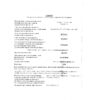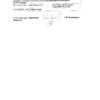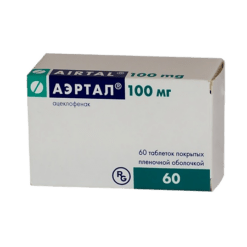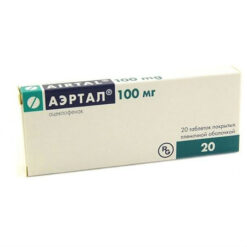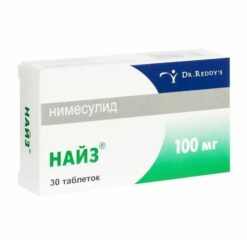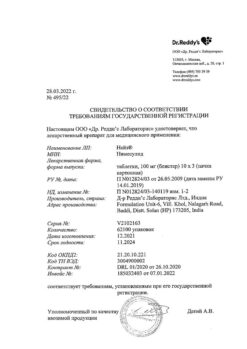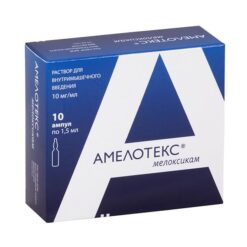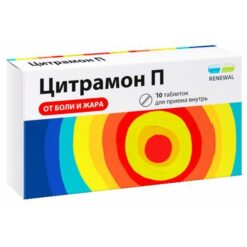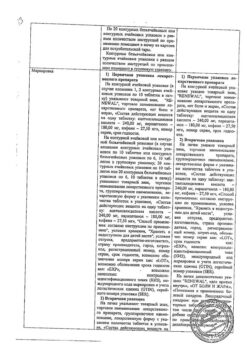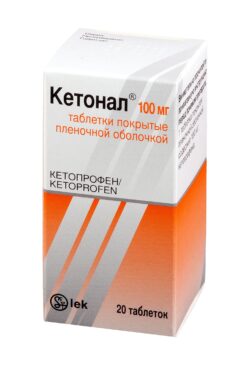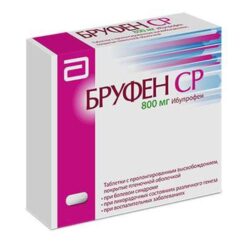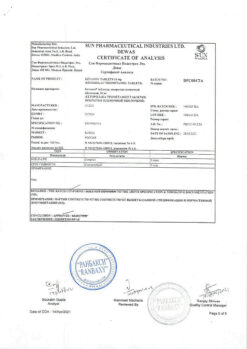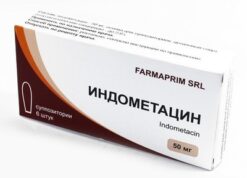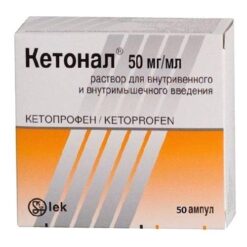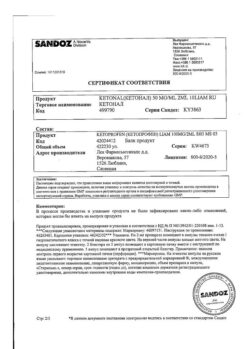No products in the cart.
Aertal, cream 1.5% 60 g
€14.30 €11.91
Description
Pharmacodynamics
Aceclofenac is a non-steroidal anti-inflammatory drug with anti-inflammatory and analgesic effects. The drug suppresses the development of edema and erythema regardless of the etiology of inflammation. Aceclofenac inhibits the formation of prostaglandins and leukotrienes due to reversible inhibition of cyclooxygenase types 1 and 2.
The established clinical efficacy of the drug is complemented by good tolerability. The use of Aerthal® cream is advisable in patients with traumatic injuries or inflammatory diseases of the musculoskeletal system.
Pharmacokinetics
Intake
After application, aceclofenac is absorbed from the application area, quickly reaching saturation. It accumulates in the area of absorption, which contributes to increased anti-inflammatory activity, and gradually enters the systemic bloodstream in small amounts, so the risk of side effects, including on the gastrointestinal tract, is minimized.
Distribution
Aceclofenac is distributed throughout the body.
Elimination
Aceclofenac is metabolized in the liver and is excreted slowly by the kidneys and through the intestine, partially unchanged.
Indications
Indications
Treatment of local pain due to traumatic injuries and inflammatory diseases of the musculoskeletal system, including sports injuries;
the drug can be used to reduce inflammation of tendons, ligaments, muscles and joints in cases of sprains, strains or bruises, as well as to treat lumbago, torticollis and periarthritis.
Pharmacological effect
Pharmacological effect
Pharmacodynamics
Aceclofenac is a non-steroidal anti-inflammatory drug with anti-inflammatory and analgesic effects. The drug suppresses the development of edema and erythema, regardless of the etiology of inflammation. Aceclofenac suppresses the formation of prostaglandins and leukotrienes due to reversible inhibition of cyclooxygenase types 1 and 2.
The established clinical effectiveness of the drug is complemented by good tolerability. The use of Airtal® cream is advisable in patients with traumatic injuries or inflammatory diseases of the musculoskeletal system.
Pharmacokinetics
Suction
After application, aceclofenac is absorbed from the application area, quickly reaching saturation. It accumulates in the absorption zone, which helps to increase anti-inflammatory activity, and gradually enters the systemic bloodstream in small quantities, and therefore the risk of side effects, including on the gastrointestinal tract, is minimized.
Distribution
Aceclofenac is distributed throughout the body.
Removal
Aceclofenac is metabolized in the liver and excreted slowly by the kidneys and through the intestines, partly unchanged.
Special instructions
Special instructions
If irritation develops at the site of application of Aertal® cream, it is necessary to stop using it and carry out appropriate treatment.
After applying Aertal® cream, you must wash your hands, except in cases where the hands are the place where the cream is applied.
Airtal® cream should not be applied to the eyes and mouth.
Airtal® cream should not be used to treat open wounds, mucous membranes, as well as irritation (eczematous) of the skin or in cases where there is any other pathological process on the skin at the site of application of the cream. The cream should be applied only to intact skin.
There are no data regarding the use of Aertal® cream in children.
To prevent photosensitivity reactions, protect the area to which the cream is applied from exposure to sunlight.
Hypersensitivity and skin reactions. Just like other NSAIDs, Airtal® cream may cause allergic reactions, including anaphylactic/anaphylactoid reactions, at the beginning of use. There have been reports of rare cases of serious skin reactions, including death, including exfoliative dermatitis, Stevens-Johnson syndrome and toxic epidermal necrolysis associated with the use of NSAIDs. Patients are at highest risk for such reactions early in treatment, with skin reactions occurring in most cases within the first month of treatment. If skin rash, lesions of the mucous membranes or other manifestations of hypersensitivity occur, treatment with Aertal® cream should be discontinued.
In rare cases, the varicella-zoster virus can cause serious complications such as skin and soft tissue infections. At present, the negative impact of NSAIDs on the course of these infections cannot be completely excluded. In this regard, it is not recommended to use aceclofenac for infection caused by the varicella-zoster virus.
1 g of Airtal® cream contains 0.002 g of methyl parahydroxybenzoate and 0.0005 g of propyl parahydroxybenzoate, which can cause allergic reactions (including delayed ones). Airtal® cream also contains cetyl stearyl alcohol. It may cause local skin reactions (eg contact dermatitis).
Impact on the ability to drive vehicles and other mechanisms that require increased concentration
Aertal® cream does not affect the ability to drive vehicles or operate machinery.
Active ingredient
Active ingredient
Aceclofenac
Composition
Composition
1 g of cream contains:
Active ingredient:
aceclofenac 100% micronized 0.015 g.
Excipients:
emulsion wax 0.1 g,
liquid paraffin 0.04 g,
methyl parahydroxybenzoate 0.002 g,
propyl parahydroxybenzoate 0.0005 g,
water 0.8425 g.
Tube 60 g.
Pregnancy
Pregnancy
Pregnancy
Airtal® cream is contraindicated during pregnancy. There is no information on the use of Aertal® cream during pregnancy.
Breastfeeding period
It is not known whether aceclofenac passes into breast milk. Airtal® cream should not be used during breastfeeding.
Contraindications
Contraindications
Hypersensitivity to the components of the drug (aceclofenac) or any of the excipients;
history of intolerance to NSAIDs, including diclofenac;
history of attacks of bronchial asthma, urticarial rash or acute rhinitis while taking acetylsalicylic acid (ASA) or other NSAIDs;
the presence of infection caused by the varicella-zoster virus.
pregnancy.
children under 18 years of age.
violation of the integrity of the skin at the intended site of application.
With caution: hepatic porphyria (exacerbation), erosive and ulcerative lesions of the gastrointestinal tract (in the acute phase), severe dysfunction of the liver and kidneys, CHF; bronchial asthma, urticaria or acute rhinitis caused by taking ASA or other NSAIDs; bleeding disorders (including hemophilia, prolongation of bleeding time, bleeding tendency), old age, lactation period.
Side Effects
Side Effects
The following are adverse events reported in clinical studies and post-marketing surveillance; Adverse events are grouped according to Medical Dictionary for Regulatory Activities (MedDRA) organ system classes and frequency of occurrence:
very often (≥ 1/10);
often (from ≥ 1/100 to < 1/10);
uncommon (from ≥ 1/1000 to < 1/100);
rare (from ≥ 1/10000 to < 1/1000);
very rare (<1/10000).
General disorders and disorders at the injection site: infrequently – photosensitivity reaction, erythema, itching; rarely – skin irritation; very rarely – bullous reactions (including Stevens-Johnson syndrome and toxic epidermal necrolysis).
There are very rare reports of severe skin reactions, sometimes resulting in death, including exfoliative dermatitis, Stevens-Johnson syndrome and toxic epidermal necrolysis associated with NSAID use.
Interaction
Interaction
Despite the lack of data on possible interactions of aceclofenac with other drugs, caution must be exercised when prescribing it to patients taking other drugs, especially those containing lithium and digoxin. Caution should also be exercised during concomitant therapy with anticoagulants, diuretics, or analgesics.
Overdose
Overdose
Symptoms: cases of aceclofenac overdose are unknown. The exact symptoms of an aceclofenac overdose are unknown. If misused or accidentally ingested, hypotension, renal failure, convulsions, irritation of the gastrointestinal mucosa, and respiratory depression may occur.
Treatment: symptomatic and supportive therapy is provided. Absorption of the drug should be prevented as soon as possible by gastric lavage and administration of activated charcoal.
Forced diuresis or hemoperfusion are ineffective due to the high degree of binding of aceclofenac to plasma proteins and its intensive metabolism.
Storage conditions
Storage conditions
Store at a temperature not exceeding 25 °C.
Keep out of the reach of children.
Shelf life
Shelf life
2 years.
Manufacturer
Manufacturer
Gedeon Richter, Hungary
Additional information
| Shelf life | 2 years. |
|---|---|
| Conditions of storage | Store at a temperature not exceeding 25 °C. Keep out of the reach of children. |
| Manufacturer | Gedeon Richter, Hungary |
| Medication form | exterior cream |
| Brand | Gedeon Richter |
Other forms…
Related products
Buy Aertal, cream 1.5% 60 g with delivery to USA, UK, Europe and over 120 other countries.





